PEARSON BTEC HND in Business: International Marketing Report
VerifiedAdded on 2021/08/30
|33
|7702
|392
Report
AI Summary
This report analyzes international marketing concepts, focusing on McDonald's as a case study. It begins with an overview of international marketing, including its scope and key concepts, and explores the rationale for international expansion, covering competition, economic integration, technology, and economic growth. The report then evaluates the opportunities and challenges of international marketing, such as market expansion and government barriers. It delves into market entry strategies, selection processes, and the global vs. local marketing debate, highlighting how organizations should adapt their strategies for different markets. The report provides a comprehensive analysis of McDonald's international marketing efforts, incorporating examples and recommendations.
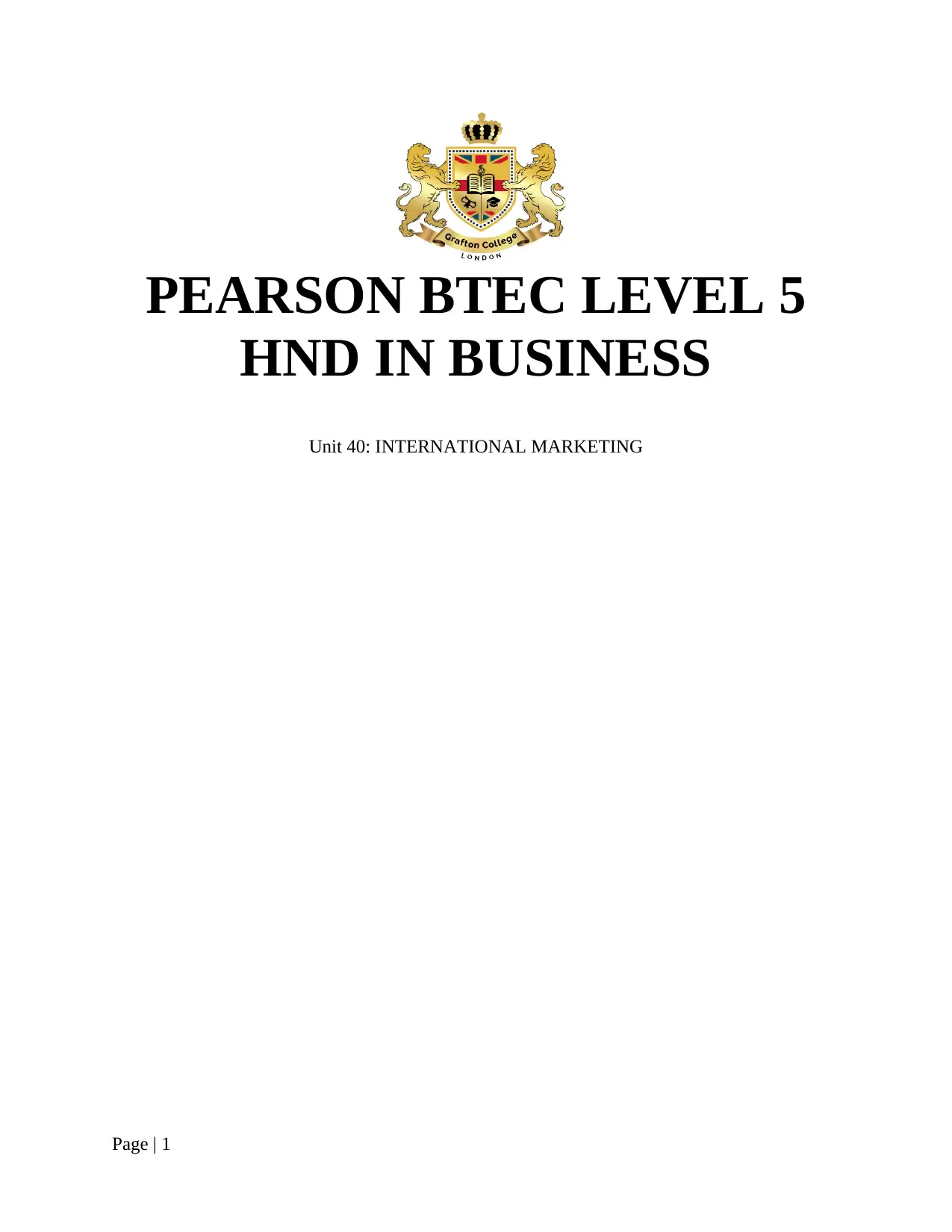
PEARSON BTEC LEVEL 5
HND IN BUSINESS
Unit 40: INTERNATIONAL MARKETING
Page | 1
HND IN BUSINESS
Unit 40: INTERNATIONAL MARKETING
Page | 1
Paraphrase This Document
Need a fresh take? Get an instant paraphrase of this document with our AI Paraphraser
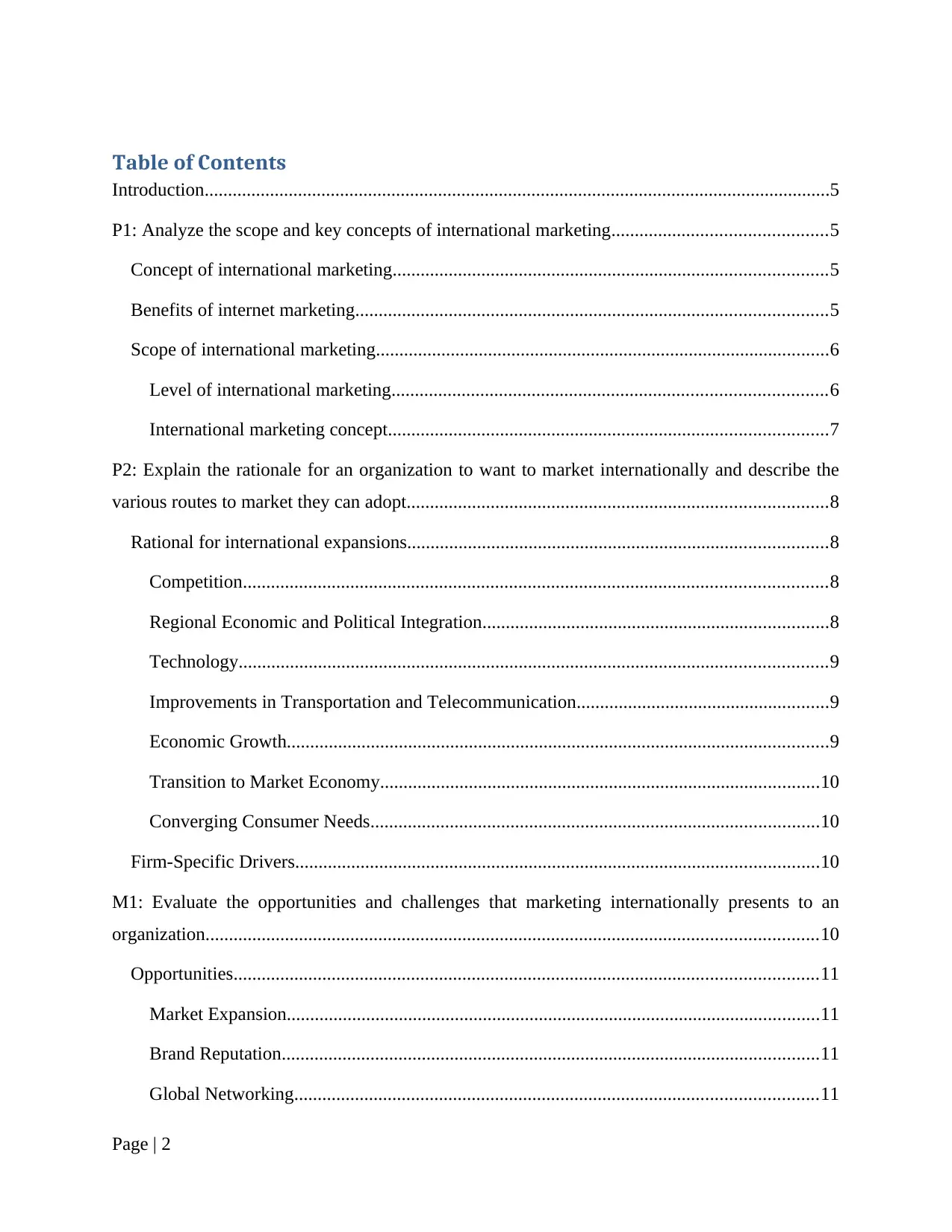
Table of Contents
Introduction......................................................................................................................................5
P1: Analyze the scope and key concepts of international marketing..............................................5
Concept of international marketing.............................................................................................5
Benefits of internet marketing.....................................................................................................5
Scope of international marketing.................................................................................................6
Level of international marketing.............................................................................................6
International marketing concept..............................................................................................7
P2: Explain the rationale for an organization to want to market internationally and describe the
various routes to market they can adopt..........................................................................................8
Rational for international expansions..........................................................................................8
Competition.............................................................................................................................8
Regional Economic and Political Integration..........................................................................8
Technology..............................................................................................................................9
Improvements in Transportation and Telecommunication......................................................9
Economic Growth....................................................................................................................9
Transition to Market Economy..............................................................................................10
Converging Consumer Needs................................................................................................10
Firm-Specific Drivers................................................................................................................10
M1: Evaluate the opportunities and challenges that marketing internationally presents to an
organization...................................................................................................................................10
Opportunities.............................................................................................................................11
Market Expansion..................................................................................................................11
Brand Reputation...................................................................................................................11
Global Networking................................................................................................................11
Page | 2
Introduction......................................................................................................................................5
P1: Analyze the scope and key concepts of international marketing..............................................5
Concept of international marketing.............................................................................................5
Benefits of internet marketing.....................................................................................................5
Scope of international marketing.................................................................................................6
Level of international marketing.............................................................................................6
International marketing concept..............................................................................................7
P2: Explain the rationale for an organization to want to market internationally and describe the
various routes to market they can adopt..........................................................................................8
Rational for international expansions..........................................................................................8
Competition.............................................................................................................................8
Regional Economic and Political Integration..........................................................................8
Technology..............................................................................................................................9
Improvements in Transportation and Telecommunication......................................................9
Economic Growth....................................................................................................................9
Transition to Market Economy..............................................................................................10
Converging Consumer Needs................................................................................................10
Firm-Specific Drivers................................................................................................................10
M1: Evaluate the opportunities and challenges that marketing internationally presents to an
organization...................................................................................................................................10
Opportunities.............................................................................................................................11
Market Expansion..................................................................................................................11
Brand Reputation...................................................................................................................11
Global Networking................................................................................................................11
Page | 2
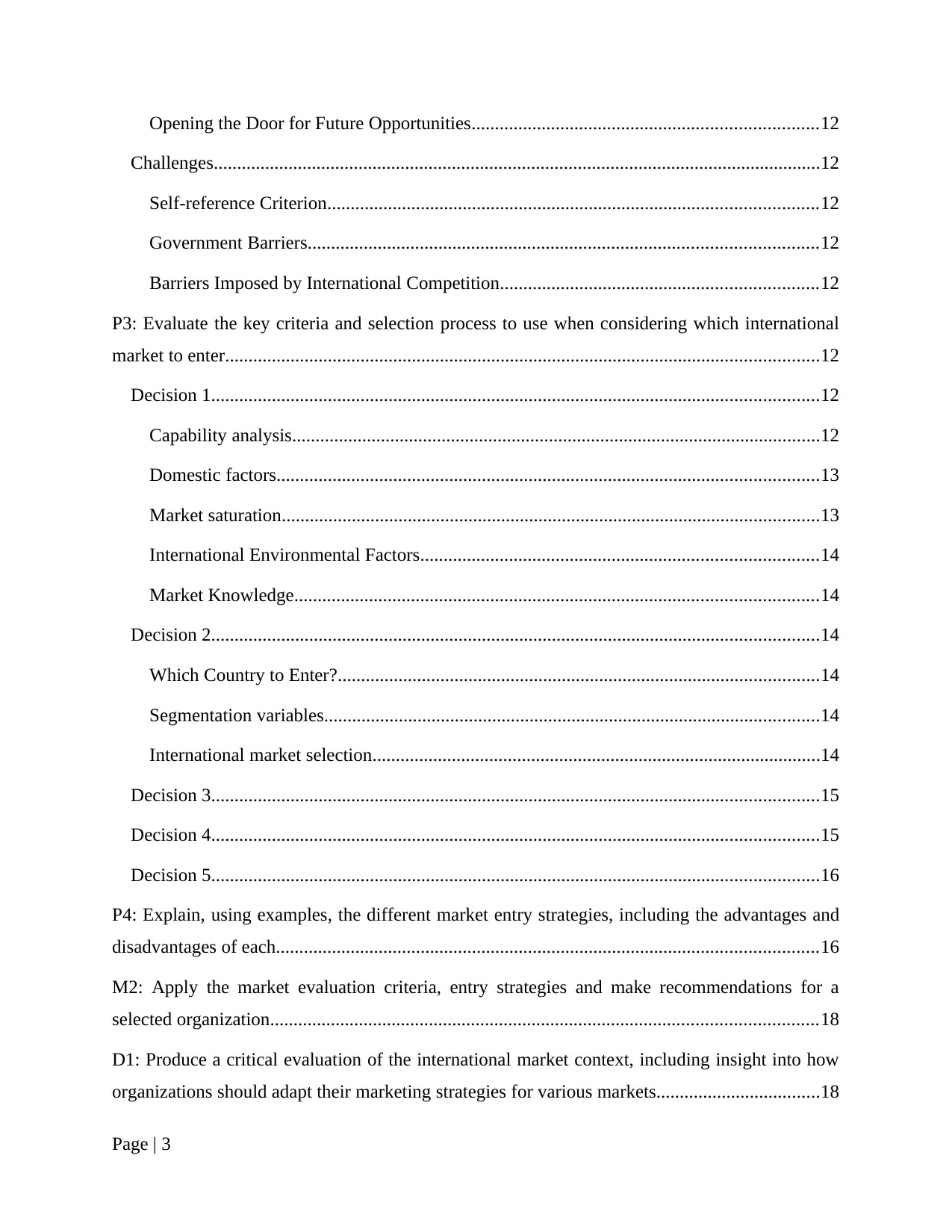
Opening the Door for Future Opportunities..........................................................................12
Challenges..................................................................................................................................12
Self-reference Criterion.........................................................................................................12
Government Barriers.............................................................................................................12
Barriers Imposed by International Competition....................................................................12
P3: Evaluate the key criteria and selection process to use when considering which international
market to enter...............................................................................................................................12
Decision 1..................................................................................................................................12
Capability analysis.................................................................................................................12
Domestic factors....................................................................................................................13
Market saturation...................................................................................................................13
International Environmental Factors.....................................................................................14
Market Knowledge................................................................................................................14
Decision 2..................................................................................................................................14
Which Country to Enter?.......................................................................................................14
Segmentation variables..........................................................................................................14
International market selection................................................................................................14
Decision 3..................................................................................................................................15
Decision 4..................................................................................................................................15
Decision 5..................................................................................................................................16
P4: Explain, using examples, the different market entry strategies, including the advantages and
disadvantages of each....................................................................................................................16
M2: Apply the market evaluation criteria, entry strategies and make recommendations for a
selected organization.....................................................................................................................18
D1: Produce a critical evaluation of the international market context, including insight into how
organizations should adapt their marketing strategies for various markets...................................18
Page | 3
Challenges..................................................................................................................................12
Self-reference Criterion.........................................................................................................12
Government Barriers.............................................................................................................12
Barriers Imposed by International Competition....................................................................12
P3: Evaluate the key criteria and selection process to use when considering which international
market to enter...............................................................................................................................12
Decision 1..................................................................................................................................12
Capability analysis.................................................................................................................12
Domestic factors....................................................................................................................13
Market saturation...................................................................................................................13
International Environmental Factors.....................................................................................14
Market Knowledge................................................................................................................14
Decision 2..................................................................................................................................14
Which Country to Enter?.......................................................................................................14
Segmentation variables..........................................................................................................14
International market selection................................................................................................14
Decision 3..................................................................................................................................15
Decision 4..................................................................................................................................15
Decision 5..................................................................................................................................16
P4: Explain, using examples, the different market entry strategies, including the advantages and
disadvantages of each....................................................................................................................16
M2: Apply the market evaluation criteria, entry strategies and make recommendations for a
selected organization.....................................................................................................................18
D1: Produce a critical evaluation of the international market context, including insight into how
organizations should adapt their marketing strategies for various markets...................................18
Page | 3
⊘ This is a preview!⊘
Do you want full access?
Subscribe today to unlock all pages.

Trusted by 1+ million students worldwide
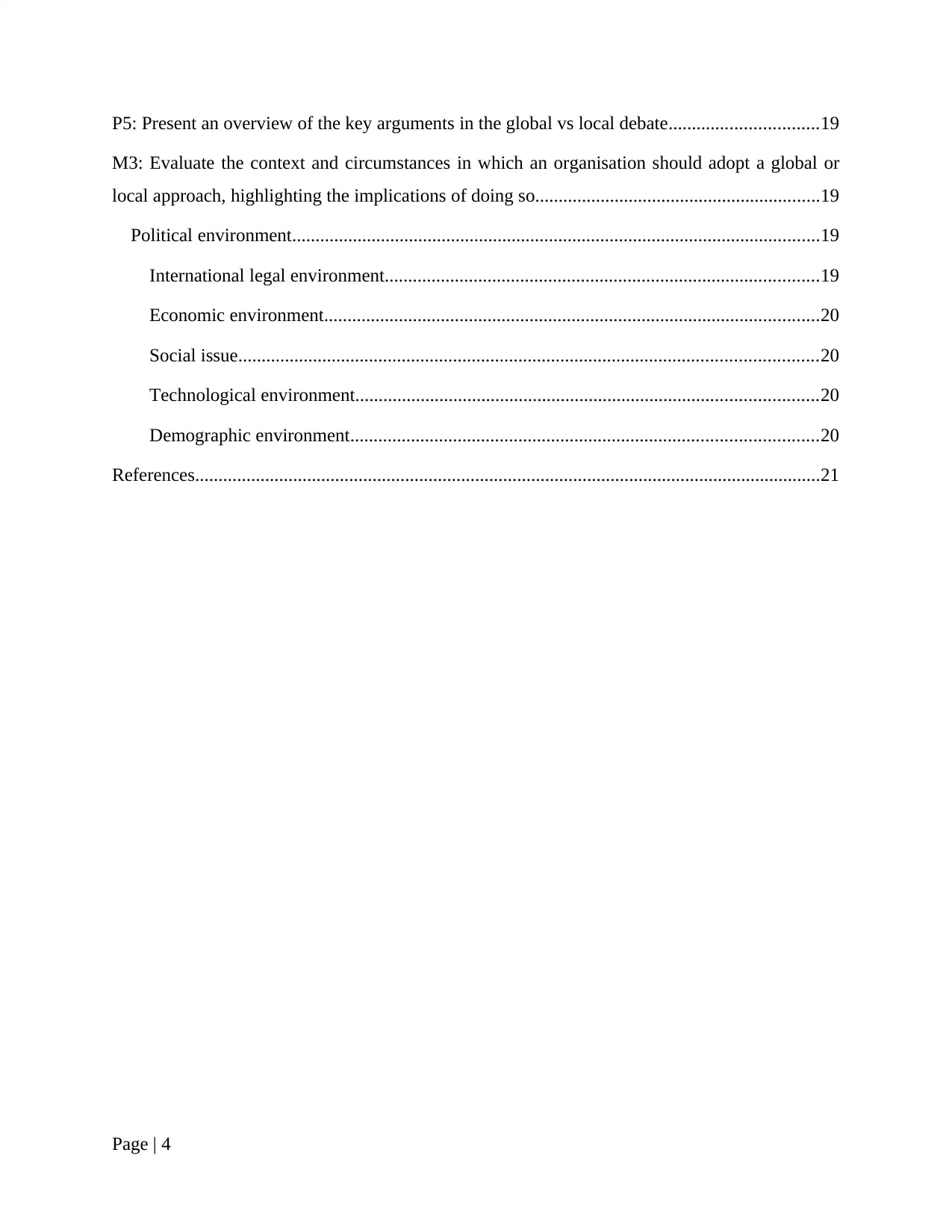
P5: Present an overview of the key arguments in the global vs local debate................................19
M3: Evaluate the context and circumstances in which an organisation should adopt a global or
local approach, highlighting the implications of doing so.............................................................19
Political environment.................................................................................................................19
International legal environment.............................................................................................19
Economic environment..........................................................................................................20
Social issue............................................................................................................................20
Technological environment...................................................................................................20
Demographic environment....................................................................................................20
References......................................................................................................................................21
Page | 4
M3: Evaluate the context and circumstances in which an organisation should adopt a global or
local approach, highlighting the implications of doing so.............................................................19
Political environment.................................................................................................................19
International legal environment.............................................................................................19
Economic environment..........................................................................................................20
Social issue............................................................................................................................20
Technological environment...................................................................................................20
Demographic environment....................................................................................................20
References......................................................................................................................................21
Page | 4
Paraphrase This Document
Need a fresh take? Get an instant paraphrase of this document with our AI Paraphraser
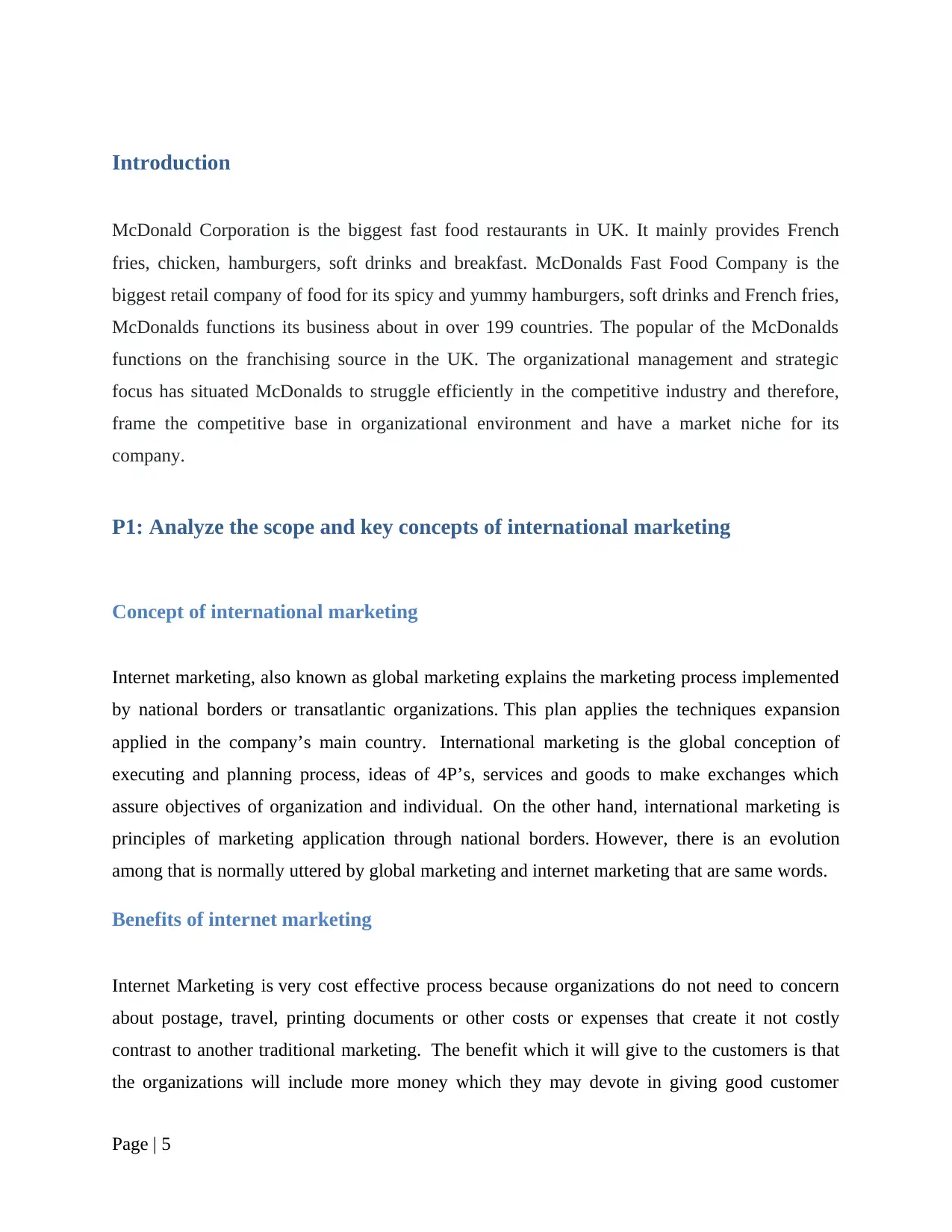
Introduction
McDonald Corporation is the biggest fast food restaurants in UK. It mainly provides French
fries, chicken, hamburgers, soft drinks and breakfast. McDonalds Fast Food Company is the
biggest retail company of food for its spicy and yummy hamburgers, soft drinks and French fries,
McDonalds functions its business about in over 199 countries. The popular of the McDonalds
functions on the franchising source in the UK. The organizational management and strategic
focus has situated McDonalds to struggle efficiently in the competitive industry and therefore,
frame the competitive base in organizational environment and have a market niche for its
company.
P1: Analyze the scope and key concepts of international marketing
Concept of international marketing
Internet marketing, also known as global marketing explains the marketing process implemented
by national borders or transatlantic organizations. This plan applies the techniques expansion
applied in the company’s main country. International marketing is the global conception of
executing and planning process, ideas of 4P’s, services and goods to make exchanges which
assure objectives of organization and individual. On the other hand, international marketing is
principles of marketing application through national borders. However, there is an evolution
among that is normally uttered by global marketing and internet marketing that are same words.
Benefits of internet marketing
Internet Marketing is very cost effective process because organizations do not need to concern
about postage, travel, printing documents or other costs or expenses that create it not costly
contrast to another traditional marketing. The benefit which it will give to the customers is that
the organizations will include more money which they may devote in giving good customer
Page | 5
McDonald Corporation is the biggest fast food restaurants in UK. It mainly provides French
fries, chicken, hamburgers, soft drinks and breakfast. McDonalds Fast Food Company is the
biggest retail company of food for its spicy and yummy hamburgers, soft drinks and French fries,
McDonalds functions its business about in over 199 countries. The popular of the McDonalds
functions on the franchising source in the UK. The organizational management and strategic
focus has situated McDonalds to struggle efficiently in the competitive industry and therefore,
frame the competitive base in organizational environment and have a market niche for its
company.
P1: Analyze the scope and key concepts of international marketing
Concept of international marketing
Internet marketing, also known as global marketing explains the marketing process implemented
by national borders or transatlantic organizations. This plan applies the techniques expansion
applied in the company’s main country. International marketing is the global conception of
executing and planning process, ideas of 4P’s, services and goods to make exchanges which
assure objectives of organization and individual. On the other hand, international marketing is
principles of marketing application through national borders. However, there is an evolution
among that is normally uttered by global marketing and internet marketing that are same words.
Benefits of internet marketing
Internet Marketing is very cost effective process because organizations do not need to concern
about postage, travel, printing documents or other costs or expenses that create it not costly
contrast to another traditional marketing. The benefit which it will give to the customers is that
the organizations will include more money which they may devote in giving good customer
Page | 5
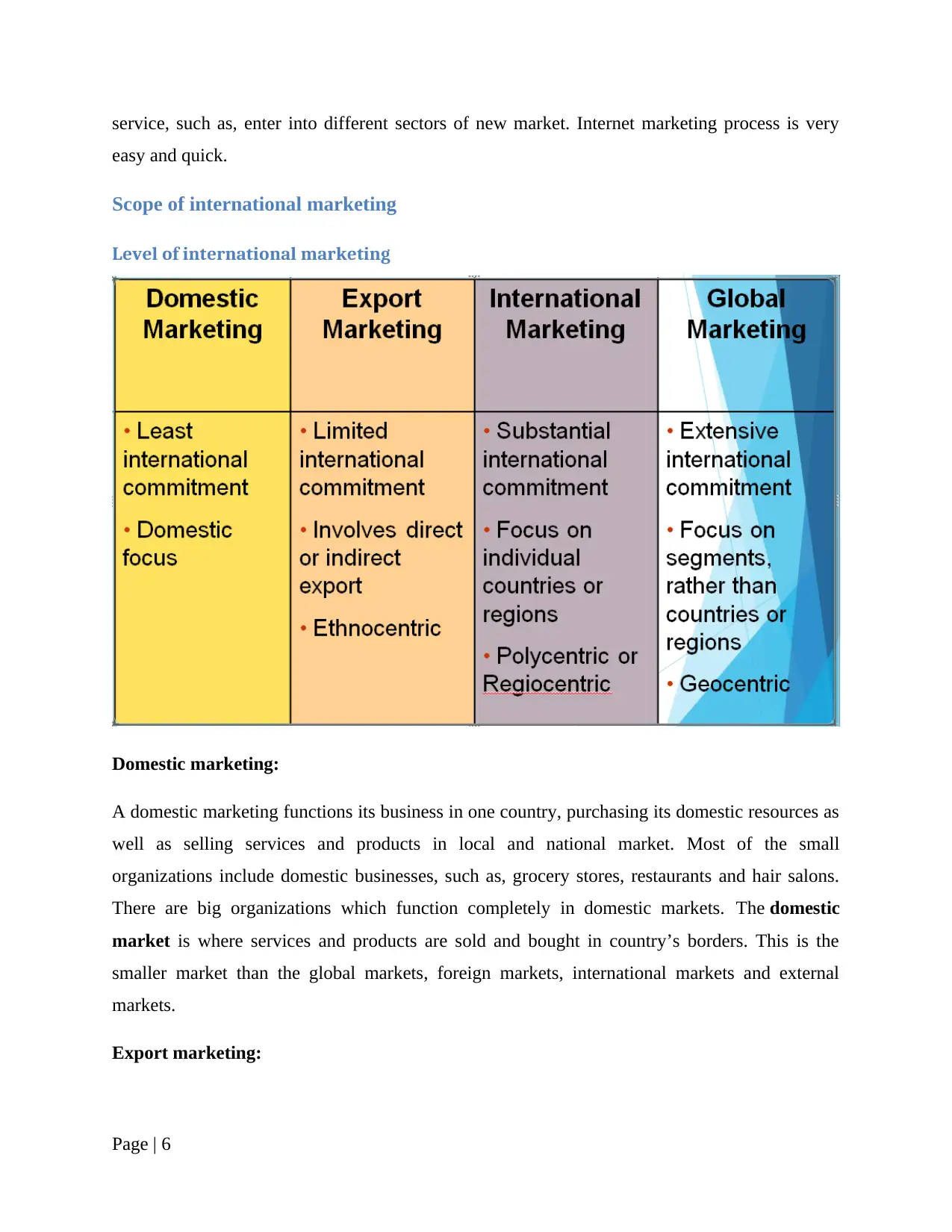
service, such as, enter into different sectors of new market. Internet marketing process is very
easy and quick.
Scope of international marketing
Level of international marketing
Domestic marketing:
A domestic marketing functions its business in one country, purchasing its domestic resources as
well as selling services and products in local and national market. Most of the small
organizations include domestic businesses, such as, grocery stores, restaurants and hair salons.
There are big organizations which function completely in domestic markets. The domestic
market is where services and products are sold and bought in country’s borders. This is the
smaller market than the global markets, foreign markets, international markets and external
markets.
Export marketing:
Page | 6
easy and quick.
Scope of international marketing
Level of international marketing
Domestic marketing:
A domestic marketing functions its business in one country, purchasing its domestic resources as
well as selling services and products in local and national market. Most of the small
organizations include domestic businesses, such as, grocery stores, restaurants and hair salons.
There are big organizations which function completely in domestic markets. The domestic
market is where services and products are sold and bought in country’s borders. This is the
smaller market than the global markets, foreign markets, international markets and external
markets.
Export marketing:
Page | 6
⊘ This is a preview!⊘
Do you want full access?
Subscribe today to unlock all pages.

Trusted by 1+ million students worldwide
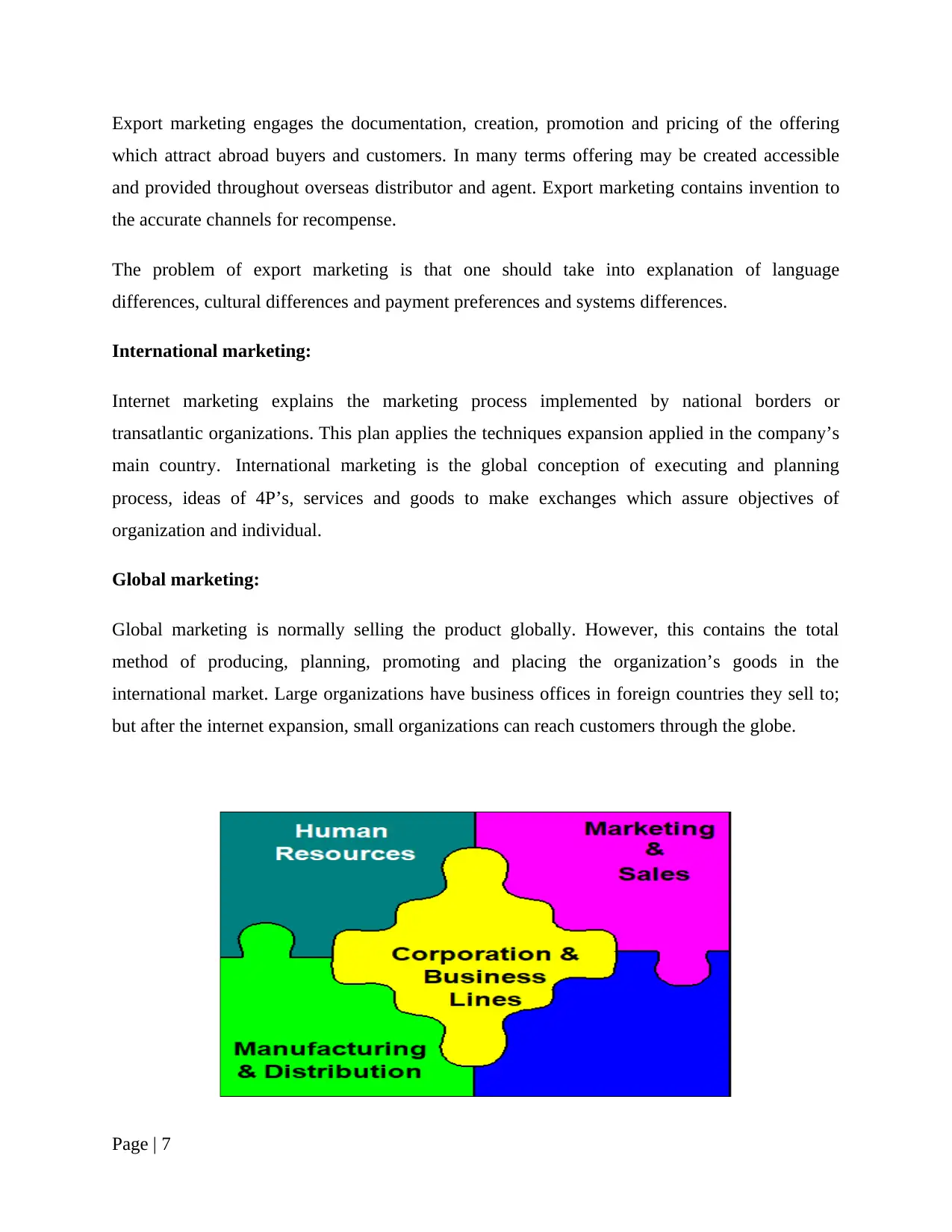
Export marketing engages the documentation, creation, promotion and pricing of the offering
which attract abroad buyers and customers. In many terms offering may be created accessible
and provided throughout overseas distributor and agent. Export marketing contains invention to
the accurate channels for recompense.
The problem of export marketing is that one should take into explanation of language
differences, cultural differences and payment preferences and systems differences.
International marketing:
Internet marketing explains the marketing process implemented by national borders or
transatlantic organizations. This plan applies the techniques expansion applied in the company’s
main country. International marketing is the global conception of executing and planning
process, ideas of 4P’s, services and goods to make exchanges which assure objectives of
organization and individual.
Global marketing:
Global marketing is normally selling the product globally. However, this contains the total
method of producing, planning, promoting and placing the organization’s goods in the
international market. Large organizations have business offices in foreign countries they sell to;
but after the internet expansion, small organizations can reach customers through the globe.
Page | 7
which attract abroad buyers and customers. In many terms offering may be created accessible
and provided throughout overseas distributor and agent. Export marketing contains invention to
the accurate channels for recompense.
The problem of export marketing is that one should take into explanation of language
differences, cultural differences and payment preferences and systems differences.
International marketing:
Internet marketing explains the marketing process implemented by national borders or
transatlantic organizations. This plan applies the techniques expansion applied in the company’s
main country. International marketing is the global conception of executing and planning
process, ideas of 4P’s, services and goods to make exchanges which assure objectives of
organization and individual.
Global marketing:
Global marketing is normally selling the product globally. However, this contains the total
method of producing, planning, promoting and placing the organization’s goods in the
international market. Large organizations have business offices in foreign countries they sell to;
but after the internet expansion, small organizations can reach customers through the globe.
Page | 7
Paraphrase This Document
Need a fresh take? Get an instant paraphrase of this document with our AI Paraphraser
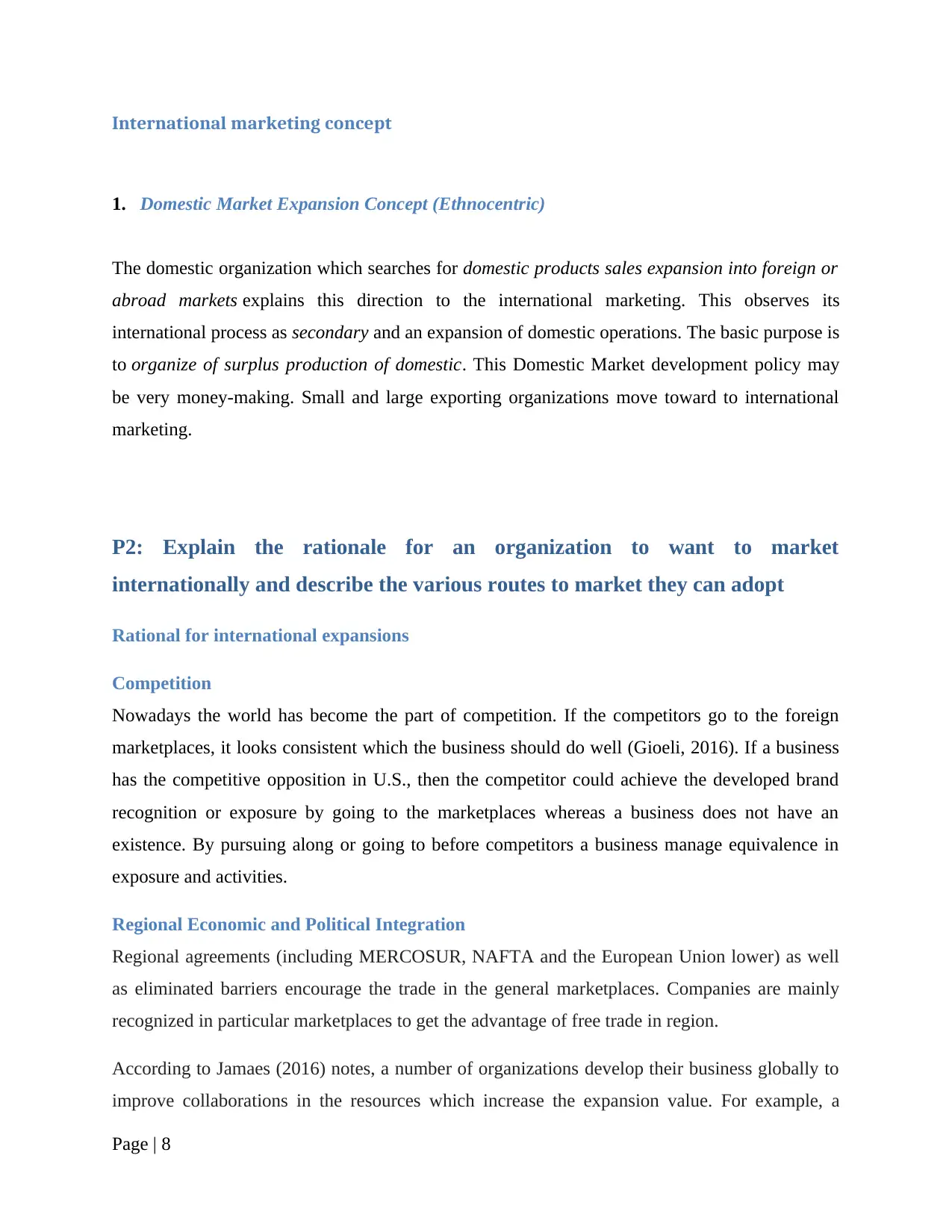
International marketing concept
1. Domestic Market Expansion Concept (Ethnocentric)
The domestic organization which searches for domestic products sales expansion into foreign or
abroad markets explains this direction to the international marketing. This observes its
international process as secondary and an expansion of domestic operations. The basic purpose is
to organize of surplus production of domestic. This Domestic Market development policy may
be very money-making. Small and large exporting organizations move toward to international
marketing.
P2: Explain the rationale for an organization to want to market
internationally and describe the various routes to market they can adopt
Rational for international expansions
Competition
Nowadays the world has become the part of competition. If the competitors go to the foreign
marketplaces, it looks consistent which the business should do well (Gioeli, 2016). If a business
has the competitive opposition in U.S., then the competitor could achieve the developed brand
recognition or exposure by going to the marketplaces whereas a business does not have an
existence. By pursuing along or going to before competitors a business manage equivalence in
exposure and activities.
Regional Economic and Political Integration
Regional agreements (including MERCOSUR, NAFTA and the European Union lower) as well
as eliminated barriers encourage the trade in the general marketplaces. Companies are mainly
recognized in particular marketplaces to get the advantage of free trade in region.
According to Jamaes (2016) notes, a number of organizations develop their business globally to
improve collaborations in the resources which increase the expansion value. For example, a
Page | 8
1. Domestic Market Expansion Concept (Ethnocentric)
The domestic organization which searches for domestic products sales expansion into foreign or
abroad markets explains this direction to the international marketing. This observes its
international process as secondary and an expansion of domestic operations. The basic purpose is
to organize of surplus production of domestic. This Domestic Market development policy may
be very money-making. Small and large exporting organizations move toward to international
marketing.
P2: Explain the rationale for an organization to want to market
internationally and describe the various routes to market they can adopt
Rational for international expansions
Competition
Nowadays the world has become the part of competition. If the competitors go to the foreign
marketplaces, it looks consistent which the business should do well (Gioeli, 2016). If a business
has the competitive opposition in U.S., then the competitor could achieve the developed brand
recognition or exposure by going to the marketplaces whereas a business does not have an
existence. By pursuing along or going to before competitors a business manage equivalence in
exposure and activities.
Regional Economic and Political Integration
Regional agreements (including MERCOSUR, NAFTA and the European Union lower) as well
as eliminated barriers encourage the trade in the general marketplaces. Companies are mainly
recognized in particular marketplaces to get the advantage of free trade in region.
According to Jamaes (2016) notes, a number of organizations develop their business globally to
improve collaborations in the resources which increase the expansion value. For example, a
Page | 8
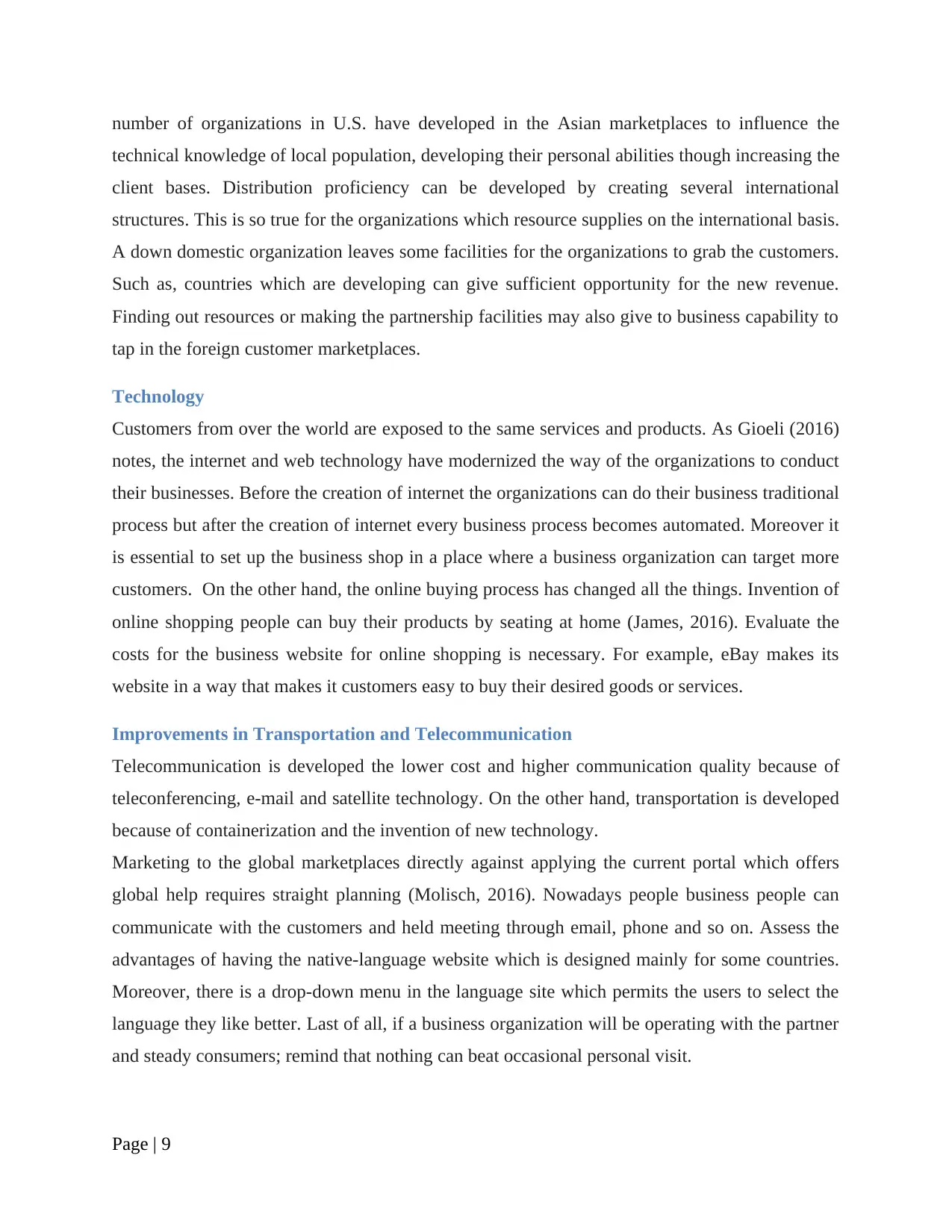
number of organizations in U.S. have developed in the Asian marketplaces to influence the
technical knowledge of local population, developing their personal abilities though increasing the
client bases. Distribution proficiency can be developed by creating several international
structures. This is so true for the organizations which resource supplies on the international basis.
A down domestic organization leaves some facilities for the organizations to grab the customers.
Such as, countries which are developing can give sufficient opportunity for the new revenue.
Finding out resources or making the partnership facilities may also give to business capability to
tap in the foreign customer marketplaces.
Technology
Customers from over the world are exposed to the same services and products. As Gioeli (2016)
notes, the internet and web technology have modernized the way of the organizations to conduct
their businesses. Before the creation of internet the organizations can do their business traditional
process but after the creation of internet every business process becomes automated. Moreover it
is essential to set up the business shop in a place where a business organization can target more
customers. On the other hand, the online buying process has changed all the things. Invention of
online shopping people can buy their products by seating at home (James, 2016). Evaluate the
costs for the business website for online shopping is necessary. For example, eBay makes its
website in a way that makes it customers easy to buy their desired goods or services.
Improvements in Transportation and Telecommunication
Telecommunication is developed the lower cost and higher communication quality because of
teleconferencing, e-mail and satellite technology. On the other hand, transportation is developed
because of containerization and the invention of new technology.
Marketing to the global marketplaces directly against applying the current portal which offers
global help requires straight planning (Molisch, 2016). Nowadays people business people can
communicate with the customers and held meeting through email, phone and so on. Assess the
advantages of having the native-language website which is designed mainly for some countries.
Moreover, there is a drop-down menu in the language site which permits the users to select the
language they like better. Last of all, if a business organization will be operating with the partner
and steady consumers; remind that nothing can beat occasional personal visit.
Page | 9
technical knowledge of local population, developing their personal abilities though increasing the
client bases. Distribution proficiency can be developed by creating several international
structures. This is so true for the organizations which resource supplies on the international basis.
A down domestic organization leaves some facilities for the organizations to grab the customers.
Such as, countries which are developing can give sufficient opportunity for the new revenue.
Finding out resources or making the partnership facilities may also give to business capability to
tap in the foreign customer marketplaces.
Technology
Customers from over the world are exposed to the same services and products. As Gioeli (2016)
notes, the internet and web technology have modernized the way of the organizations to conduct
their businesses. Before the creation of internet the organizations can do their business traditional
process but after the creation of internet every business process becomes automated. Moreover it
is essential to set up the business shop in a place where a business organization can target more
customers. On the other hand, the online buying process has changed all the things. Invention of
online shopping people can buy their products by seating at home (James, 2016). Evaluate the
costs for the business website for online shopping is necessary. For example, eBay makes its
website in a way that makes it customers easy to buy their desired goods or services.
Improvements in Transportation and Telecommunication
Telecommunication is developed the lower cost and higher communication quality because of
teleconferencing, e-mail and satellite technology. On the other hand, transportation is developed
because of containerization and the invention of new technology.
Marketing to the global marketplaces directly against applying the current portal which offers
global help requires straight planning (Molisch, 2016). Nowadays people business people can
communicate with the customers and held meeting through email, phone and so on. Assess the
advantages of having the native-language website which is designed mainly for some countries.
Moreover, there is a drop-down menu in the language site which permits the users to select the
language they like better. Last of all, if a business organization will be operating with the partner
and steady consumers; remind that nothing can beat occasional personal visit.
Page | 9
⊘ This is a preview!⊘
Do you want full access?
Subscribe today to unlock all pages.

Trusted by 1+ million students worldwide
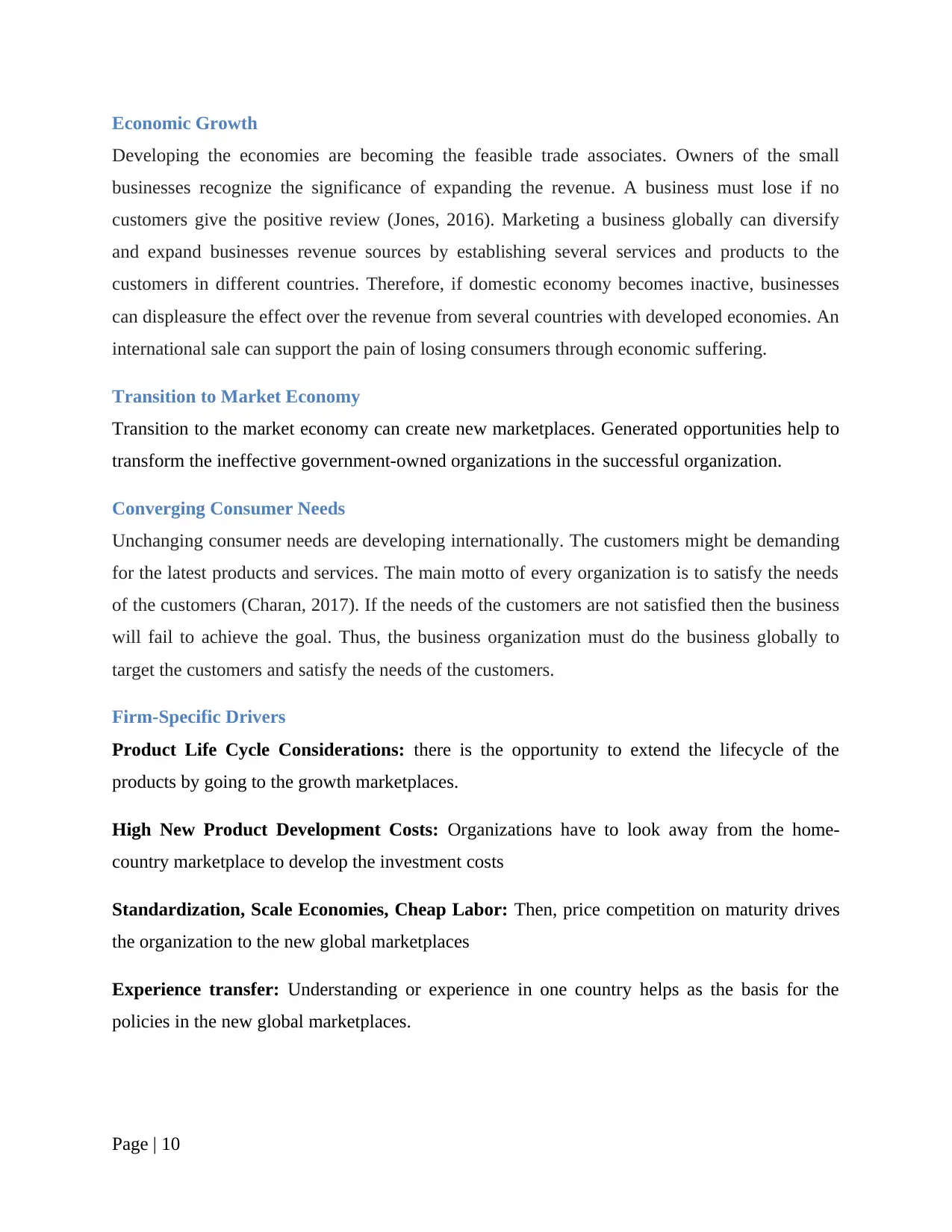
Economic Growth
Developing the economies are becoming the feasible trade associates. Owners of the small
businesses recognize the significance of expanding the revenue. A business must lose if no
customers give the positive review (Jones, 2016). Marketing a business globally can diversify
and expand businesses revenue sources by establishing several services and products to the
customers in different countries. Therefore, if domestic economy becomes inactive, businesses
can displeasure the effect over the revenue from several countries with developed economies. An
international sale can support the pain of losing consumers through economic suffering.
Transition to Market Economy
Transition to the market economy can create new marketplaces. Generated opportunities help to
transform the ineffective government-owned organizations in the successful organization.
Converging Consumer Needs
Unchanging consumer needs are developing internationally. The customers might be demanding
for the latest products and services. The main motto of every organization is to satisfy the needs
of the customers (Charan, 2017). If the needs of the customers are not satisfied then the business
will fail to achieve the goal. Thus, the business organization must do the business globally to
target the customers and satisfy the needs of the customers.
Firm-Specific Drivers
Product Life Cycle Considerations: there is the opportunity to extend the lifecycle of the
products by going to the growth marketplaces.
High New Product Development Costs: Organizations have to look away from the home-
country marketplace to develop the investment costs
Standardization, Scale Economies, Cheap Labor: Then, price competition on maturity drives
the organization to the new global marketplaces
Experience transfer: Understanding or experience in one country helps as the basis for the
policies in the new global marketplaces.
Page | 10
Developing the economies are becoming the feasible trade associates. Owners of the small
businesses recognize the significance of expanding the revenue. A business must lose if no
customers give the positive review (Jones, 2016). Marketing a business globally can diversify
and expand businesses revenue sources by establishing several services and products to the
customers in different countries. Therefore, if domestic economy becomes inactive, businesses
can displeasure the effect over the revenue from several countries with developed economies. An
international sale can support the pain of losing consumers through economic suffering.
Transition to Market Economy
Transition to the market economy can create new marketplaces. Generated opportunities help to
transform the ineffective government-owned organizations in the successful organization.
Converging Consumer Needs
Unchanging consumer needs are developing internationally. The customers might be demanding
for the latest products and services. The main motto of every organization is to satisfy the needs
of the customers (Charan, 2017). If the needs of the customers are not satisfied then the business
will fail to achieve the goal. Thus, the business organization must do the business globally to
target the customers and satisfy the needs of the customers.
Firm-Specific Drivers
Product Life Cycle Considerations: there is the opportunity to extend the lifecycle of the
products by going to the growth marketplaces.
High New Product Development Costs: Organizations have to look away from the home-
country marketplace to develop the investment costs
Standardization, Scale Economies, Cheap Labor: Then, price competition on maturity drives
the organization to the new global marketplaces
Experience transfer: Understanding or experience in one country helps as the basis for the
policies in the new global marketplaces.
Page | 10
Paraphrase This Document
Need a fresh take? Get an instant paraphrase of this document with our AI Paraphraser

M1: Evaluate the opportunities and challenges that marketing internationally
presents to an organization.
Several opportunities and challenges of the business in the global marketplace can be assessed by
evaluating both micro and macro environment of the business. The forces in the immediate
environment of the organization that directly impact the decisions or operations of the
organizations can define micro environment (Bailey, 2016). Suppliers, different marketplace
mediators and several service organizations including transporters, middlemen, and agencies of
advertising and marketing research, general public and competitors are included by these. Macro
environment includes wider forces that influence the organizations and the other forces in the
micro environment of the organization. These contain several factors (including political, legal,
economic, social etc.). Moreover, organizations want to constantly manage the changes in these
environmental forces as well as develop policies to tackle with them.
The finding of macro and micro analysis of McDonald’s in the China marketplace
recognizes several challenges or opportunities which are described as below.
Opportunities
Market Expansion
As Biley (2016) notes, market expansion is the great advantage of marketing globally. Increasing
the places whereas an organization does business as well as promotes its services or products to
open up the broader customer base and possibly develop the profit margins. On the other hand,
small organizations may discover that marketing globally is high-priced, several technology
(including social media advertising services and online newspaper have created the global
marketing process very attractive.
Brand Reputation
Global marketing can has the great advantage of supporting to develop the reputation of the
brand of a business. Customers always search for the branded and quality products. For example,
the well-known automobile industries are the great example. Customers are like to purchase the
products which are broadly accessible (Dodson, 2016).
Page | 11
presents to an organization.
Several opportunities and challenges of the business in the global marketplace can be assessed by
evaluating both micro and macro environment of the business. The forces in the immediate
environment of the organization that directly impact the decisions or operations of the
organizations can define micro environment (Bailey, 2016). Suppliers, different marketplace
mediators and several service organizations including transporters, middlemen, and agencies of
advertising and marketing research, general public and competitors are included by these. Macro
environment includes wider forces that influence the organizations and the other forces in the
micro environment of the organization. These contain several factors (including political, legal,
economic, social etc.). Moreover, organizations want to constantly manage the changes in these
environmental forces as well as develop policies to tackle with them.
The finding of macro and micro analysis of McDonald’s in the China marketplace
recognizes several challenges or opportunities which are described as below.
Opportunities
Market Expansion
As Biley (2016) notes, market expansion is the great advantage of marketing globally. Increasing
the places whereas an organization does business as well as promotes its services or products to
open up the broader customer base and possibly develop the profit margins. On the other hand,
small organizations may discover that marketing globally is high-priced, several technology
(including social media advertising services and online newspaper have created the global
marketing process very attractive.
Brand Reputation
Global marketing can has the great advantage of supporting to develop the reputation of the
brand of a business. Customers always search for the branded and quality products. For example,
the well-known automobile industries are the great example. Customers are like to purchase the
products which are broadly accessible (Dodson, 2016).
Page | 11
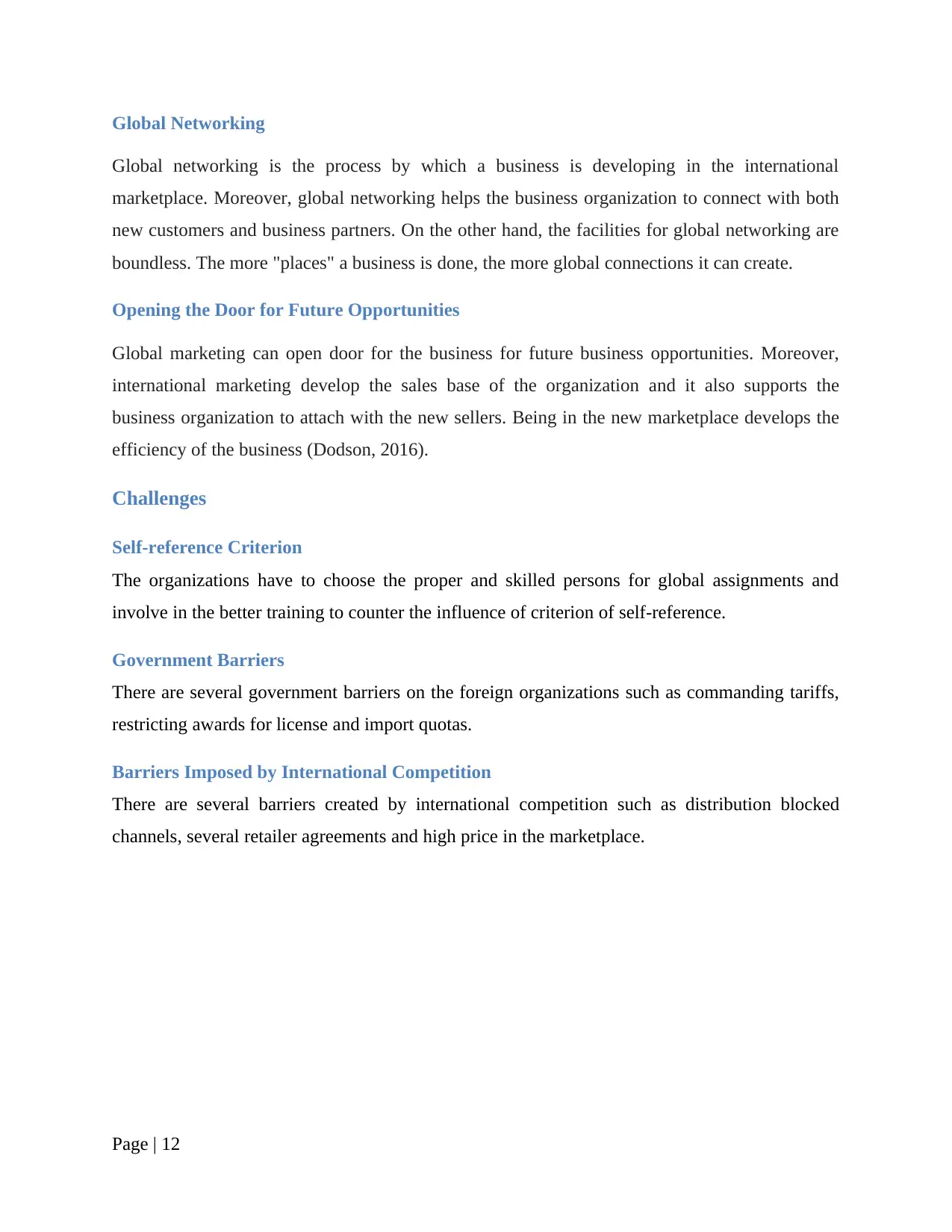
Global Networking
Global networking is the process by which a business is developing in the international
marketplace. Moreover, global networking helps the business organization to connect with both
new customers and business partners. On the other hand, the facilities for global networking are
boundless. The more "places" a business is done, the more global connections it can create.
Opening the Door for Future Opportunities
Global marketing can open door for the business for future business opportunities. Moreover,
international marketing develop the sales base of the organization and it also supports the
business organization to attach with the new sellers. Being in the new marketplace develops the
efficiency of the business (Dodson, 2016).
Challenges
Self-reference Criterion
The organizations have to choose the proper and skilled persons for global assignments and
involve in the better training to counter the influence of criterion of self-reference.
Government Barriers
There are several government barriers on the foreign organizations such as commanding tariffs,
restricting awards for license and import quotas.
Barriers Imposed by International Competition
There are several barriers created by international competition such as distribution blocked
channels, several retailer agreements and high price in the marketplace.
Page | 12
Global networking is the process by which a business is developing in the international
marketplace. Moreover, global networking helps the business organization to connect with both
new customers and business partners. On the other hand, the facilities for global networking are
boundless. The more "places" a business is done, the more global connections it can create.
Opening the Door for Future Opportunities
Global marketing can open door for the business for future business opportunities. Moreover,
international marketing develop the sales base of the organization and it also supports the
business organization to attach with the new sellers. Being in the new marketplace develops the
efficiency of the business (Dodson, 2016).
Challenges
Self-reference Criterion
The organizations have to choose the proper and skilled persons for global assignments and
involve in the better training to counter the influence of criterion of self-reference.
Government Barriers
There are several government barriers on the foreign organizations such as commanding tariffs,
restricting awards for license and import quotas.
Barriers Imposed by International Competition
There are several barriers created by international competition such as distribution blocked
channels, several retailer agreements and high price in the marketplace.
Page | 12
⊘ This is a preview!⊘
Do you want full access?
Subscribe today to unlock all pages.

Trusted by 1+ million students worldwide
1 out of 33
Related Documents
Your All-in-One AI-Powered Toolkit for Academic Success.
+13062052269
info@desklib.com
Available 24*7 on WhatsApp / Email
![[object Object]](/_next/static/media/star-bottom.7253800d.svg)
Unlock your academic potential
Copyright © 2020–2025 A2Z Services. All Rights Reserved. Developed and managed by ZUCOL.




